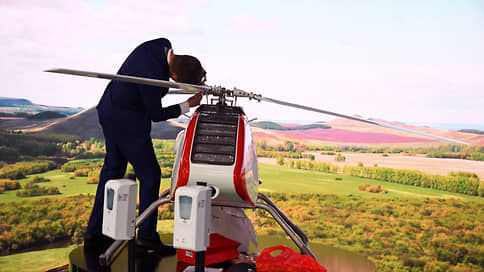The idea of the Ministry of Industry and Trade to abandon foreign drones divided the industry
[ad_1]

Participants in the drone market differed in their assessments of the initiative of the Ministry of Industry and Trade to ban the supply of foreign devices for government orders. Some of them hope that this will help promote the products of Russian companies. Others object that it is impossible to replace foreign suppliers so quickly, and, coupled with the introduction of a localization scoring system, this will cut many players off from state tenders, whose total volume, according to the authorities, will be 200 billion rubles. by 2030. As a result, the initiative may result in the supply of “Chinese drones with Russian nameplates” to departments and state-owned companies, and an increase in the cost of equipment and services.
Manufacturers of unmanned vehicles differed in assessing the consequences of the ban on foreign technology in the public sector. The Ministry of Industry and Trade plans to introduce “forbidden restrictions” on the purchase of foreign unmanned aerial systems (UAS) in the framework of a civil state order in the fall, Vasily Osmakov, first deputy head of the department, announced on July 12. The Ministry of Industry and Trade did not answer Kommersant.
In April, First Deputy Prime Minister Andrey Belousov reported that this year the volume of state orders (including state-owned companies) would amount to 4.4 billion rubles, the potential volume for the next two years – 93 billion rubles, until 2030 – 200 billion rubles. The largest state customers are the Ministry of Emergency Situations, the Russian Guard, Rosreestr, the Ministry of Education. From 2018 to 2022, almost 2,000 government contracts worth 13 billion rubles were signed in the Russian Federation. The share of products of Russian manufacturers in the civilian segment of the market, as reflected in the strategy for the development of unmanned aircraft until 2030, is only 22%. The strategy envisaged that this share in the state order would grow to 60% by 2026 and 80% by 2030 in the baseline scenario.
Now the strategy will be adjusted, and some market players believe that they will have time to prepare for innovations. Given the seasonality of demand (drones are rarely used in winter), Russian manufacturers have a year, says Alexei Semenov, Chairman of the Board of Geoscan Group of Companies: “For industrial drones, which mainly form a state order, this period is enough.” Temporary difficulties, in his opinion, may arise in those industries where the use of drones was prohibited and development was not carried out – for example, heavy drones for applying substances in agriculture. “But since the beginning of the year it has been clear that the ban will be lifted, and Russian companies are certainly developing these drones,” he says.
Several companies in the Russian Federation are already working in this direction, says Gleb Babintsev, head of the Aeronext association. In his opinion, protectionism will benefit the industry, as well as a scoring system for assessing localization. Other industry players have repeatedly stressed that this system could be a pretext for limiting admission to government contracts. “This is a bar to be reached, but it is achievable. Only suppliers of foreign drones can oppose it,” Mr. Babintsev objects.
The restrictions will definitely benefit Russian manufacturers, says Clevercopter CEO Sergey Gusev. At the same time, it is necessary to exclude the possibility of gray imports and sticking Russian “nameplates” on Chinese drones, he emphasizes. In his opinion, drones are still “not such a critical sector of the economy, where a sharp transition to a Russian product can cause shocks.”
However, many industry participants are skeptical. Russian companies can only produce enough aircraft-type UAS for monitoring, which are supplied by the Unmanned Systems Group (Supercam), Geoscan, Zala and others, said Vadim Kuznetsov, Deputy General Director of FINCO. But there are not enough multicopter UAS for video filming, aerial photography (AFS), as well as agricultural drones “just because of strong foreign competitors – DJI, Autel”. Moderate protectionism and subsidies can stimulate domestic producers, he notes, “but a drastic ban will lead to severe shortages and the disruption of a large number of projects.”
Other players believe that the lack of drones will arise in all areas. Russian manufacturers have low localization, recalls Alexey Rudakov, executive director of the Laboratory of the Future, which produces drones for the energy complex. The shock can be useful in its own way, he says, but at the same time the problems are deeply systemic, requiring the creation of entire industry chains and serious investments: “So far, we have not observed such points of growth.”
Based on export data, drones for monitoring and mapping will also be hit, Vitaly Munirov, general director of Kursir from NTI Aeronet, believes: “Our production is not yet ready to compensate for this in such a volume.”
Restrictions should be introduced gradually, because the state is faced with the task of developing the industry, and not “grounding” it, sharply “tightening the screws,” says Nikita Danilov, CEO and founder of Fly Dron. The same, in his opinion, also applies to possible restrictions on the degree of localization of Russian drones. Foreign components are used to some extent in the production of almost all drones, “problems, first of all, with the production of electric motors, as well as in microelectronics.” There are “almost no” problems with drone software alone, he says.
The ban on foreign equipment, coupled with a point system, will lead to the monopolization of imports by the “largest elected” players by recognizing foreign models as Russian, said Sergey Detenyshev, chairman of the board of the MalAP association. He sees the rise in the cost of products due to the narrowing of the market as the only consequence of protectionist measures. In his opinion, the development of its own component base – from engines to navigation – is hindered by administrative and financial barriers, and the point system does not motivate real growth in localization.
[ad_2]
Source link





